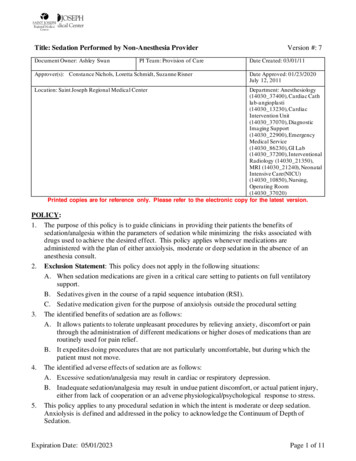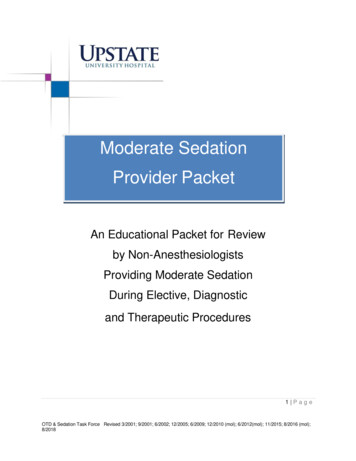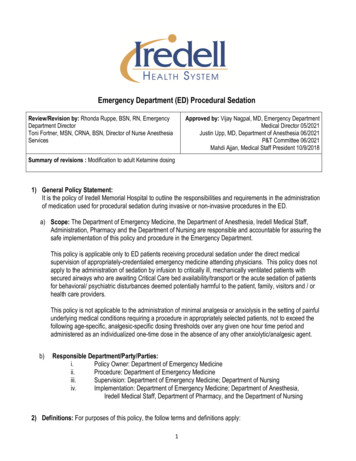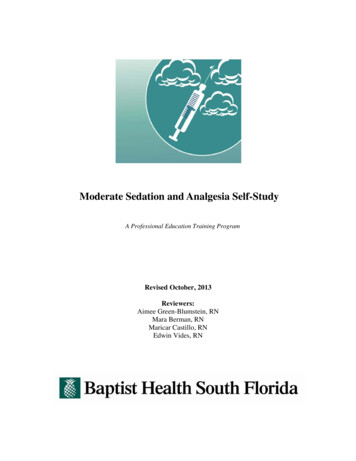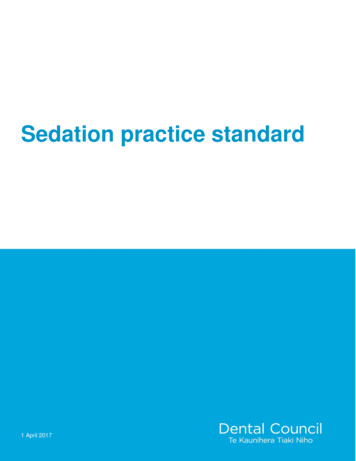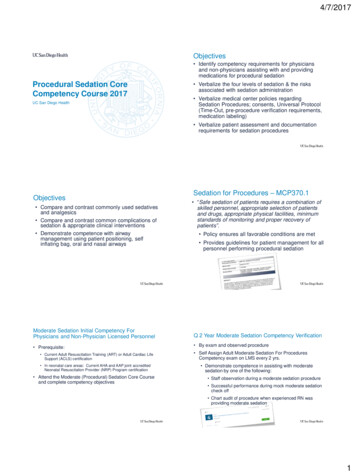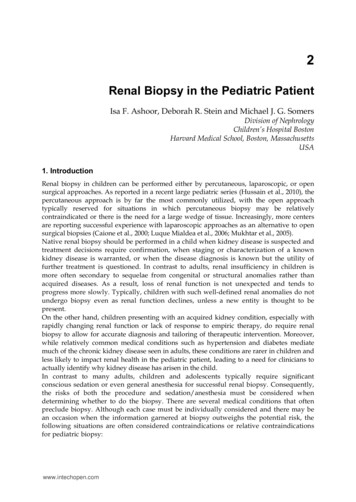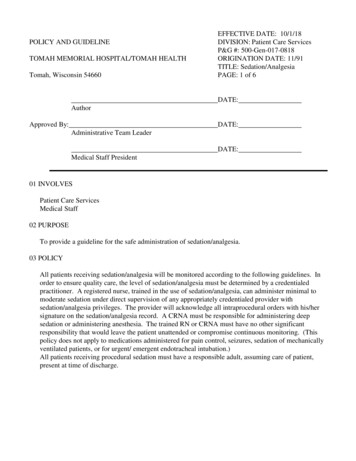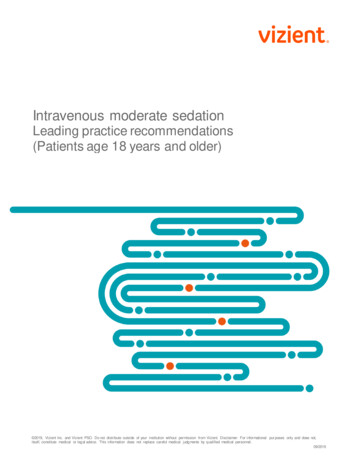
Transcription
Intravenous moderate sedationLeading practice recommendations(Patients age 18 years and older) 2019, Vizient Inc. and Vizient PSO. Do not distribute outside of your institution without permission from Vizient. Disclaimer: For informational pur poses only and does not,itself, constitute medical or legal advice. This information does not replace careful medical judgments by qualified medical personnel.09/2019
Leading Practice Recommendations for Intravenous Moderate SedationThis document provides organizations with recommendations for intravenous moderate sedation for patients whodo not have a controlled airway. Organizations should use this tool to evaluate their practices, but clinicaljudgement should always define how patients should be cared for. This document is not intended to replace theclinical judgment of physicians or other licensed professionals caring for patients. This resource is a qualityimprovement document intended to reduce morbidity and mortality. These materials are for information only , donot constitute medical or legal advice, and are not a substitute for independent professional medical judgment orlegal advice. The entire risk as to the accuracy, use, and reliance on these materials is disclaimed by Vizient.Moderate sedation by non-anesthesiologists is a high-risk and problem-prone procedure. This document is aresource to help organizations assess and improve their moderate sedation processes. It describes the structuresand processes that should be in place to promote optimal outcomes. A multidisciplinary team of health careprofessionals collaborated to define the recommendations.Moderate Sedation/Analgesia (“conscious sedation” or “MSA”): A drug-induced depression of consciousnessduring which sedatives or combinations of sedatives and analgesic medications are often used and may be titratedto effect. Moderate and deep sedation or general anesthesia may be achieved via any route of administration.Moderate sedation is characterized by: Patients respond purposefully (reflex withdrawal from a painful stimulus is not considered a purposefulresponse) to verbal commands alone or accompanied by light tactile stimulation No interventions are required to maintain a patent airway Spontaneous ventilation is adequate Cardiovascular function is usually maintainedReference:Practice Guidelines for Moderate Procedural Sedation and Analgesia 2018: A Report by the American Society ofAnesthesiologists Task Force on Moderate Procedural Sedation and Analgesia, the American Association of Oral andMaxillofacial Surgeons, American College of Radiology, American Dental Association, American Society of DentistAnesthesiologists, and Society of Interventional Radiology*. Anesthesiology 2018; 128(3):437-479. doi:10.1097/ALN.0000000000002043. Accessed April 4, 2019 2019, Vizient Inc. and Vizient PSO. Do not distribute outside of your institution without permission from Vizient. Disclaimer: For informational pur poses only and does not,itself, constitute medical or legal advice. This information does not replace careful medical judgments by qualified medical personnel.09/2019
PhaseLeading practiceReferenceRequirementsfor licensedindependentpractitioner (LIP)privilegesThe following requirements do not apply to anesthesiologistsor certified registered nurse anesthetists.Practice Guidelines forModerate ProceduralSedation and Analgesia2018: A Report by theAmerican Society ofAnesthesiologists TaskForce on ModerateProcedural Sedation andAnalgesia, the AmericanAssociation of Oral andMaxillofacial Surgeons,American College ofRadiology, American DentalAssociation, AmericanSociety of DentistAnesthesiologists, andSociety of InterventionalRadiology*. Anesthesiology2018; 1 28(3): 437-479. doi:10.1097/ALN.0000000000002043. Accessed April s inemergencymedicine,cardiology, criticalcare medicine,and oralmaxillofacialsurgery)LIP’s in the abovespecialties whohave recentlycompleted postgraduate trainingand are activelypursuing boardcertification intheir respectivespecialty mustfulfill thesecredentialingcriteria if they donot become boardcertified within twoyears ofcompleting suchtraining.Licensure, registration and certification: Valid Drug Enforcement Agency (DEA) registrationnumber, unrestricted state medical license and currentboard certification in the LIP’s primary specialty isrequired.Resuscitation Competency: Successful completion of both basic life support (BLS)and advanced cardiovascular life support (ACLS) isrequired. Both qualifications must be continuouslymaintained throughout the credentialing period.Required Airway Assessment Competency: (Exempted physicians are not required to demonstratecompetency) Demonstrate the ability to examine theairway, recognize high-risk airways, and perform aMallampati classification.High-Risk Airway: Habitus: Excessive facial hair, receding chin, orsignificant obesity especially involving the neck and facialstructures (body mass index 35) Head and Neck: Short neck, limited neck extension,decreased hyoid-mental distance ( 3 cm in an adult),neck mass, cervical spine disease/trauma, trachealdeviation, dysmorphic facial features (e.g., Pierre-Robinsyndrome) Mouth: Small opening ( 3 cm in an adult); protrudingincisors; loose or capped teeth; dental appliances; high,arched palate; macroglossia; tonsillar hypertrophy;nonvisible uvula Jaw: Micrognathia, retrognathia, trismus, or significantmalocclusionComprehensiveAccreditation Manual forHospitals (CAMH): TheOfficial Handbook. OakbrookTerrace, Ill: JointCommission onAccreditation of HealthcareOrganizations; 2019.PC 03.01.01 element ofperformance (EP) 10PC 13.20: EP 2, 6, 10, 12.Required Airway Management Competency evaluation:(Exempted physicians are not required to demonstratecompetency) Experience such as a demonstrated ability to: Recognize airway obstruction Decreased, absent, or paradoxical chestmovement Lack of airflow detectable at mouth or nose “Noisy” respirations (snoring, wheezing, gurgling,crowing) 2019, Vizient Inc. and Vizient PSO. Do not distribute outside of your institution without permission from Vizient. Disclaimer: For informational pur poses only and does not,itself, constitute medical or legal advice. This information does not replace careful medical judgments by qualified medical personnel.09/2019
PhaseRequirementsfor licensedindependentpractitioner (LIP)privileges(continued)Leading practice ReferenceInsert oral and nasal airwaysPerform a jaw thrust and chin liftUse a self-inflating bag-valve-mask deviceOperate an oxygen cylinder and flow meterOperate suction regulator and associated devicesRequired Pharmacology Competency: All nonexempt LIP’s must successfully complete aninstitutionally-approved sedation pharmacologyeducation module or course with a passing score asapproved by the institution’s anesthesia chairman thatincludes: Sedative-analgesic medication options Patient-appropriate drug selection, dosages, onset ofaction, time to peak effect, dosing intervals, duration ofaction, and side effects Dexmedetomidine mechanism and onset of action Recognition and treatment of respiratory depression,overdoses, and other agent-specific side effects Reversal agent (e.g., naloxone and flumazenil)dosages, onset of action, time to peak effect, dosingintervals, duration of action, and side effectsMonitoring: Use of and troubleshooting of equipment Cardiac monitor-defibrillator Oscillometric blood pressure Capnography Pulse OximetryRequired Sedation Policy Competency: All LIP’s (both exempt and nonexempt) must successfullycomplete an appropriate education module on theorganization’s moderate sedation policy with a passingscore as approved by the institution’s anesthesiachairman.Requirementsfor registerednurses (RNs) orothers permittedto participate bystate law andinstitutionalpolicyRequired Resuscitation Competency: Both BLS and ACLS qualifications are required and mustbe continuously maintained throughout the credentialingperiod.Required Airway Assessment Competency: Demonstrate the ability to examine an airway, recognizehigh-risk airways, and perform a Mallampati classification.High-Risk Airway: Habitus: Excessive facial hair, receding chin, orsignificant obesity especially involving the neck and facialstructures (body mass index 35)America Society ofAnesthesiologists (2018).Statement onnonoperating roomanesthetizing locations.(Approved by the ASAHouse of Delegates onOctober 19, 1994, lastamended on October 16,2013, and reaffirmed onOctober 17, 2018). 2019, Vizient Inc. and Vizient PSO. Do not distribute outside of your institution without permission from Vizient. Disclaimer: For informational pur poses only and does not,itself, constitute medical or legal advice. This information does not replace careful medical judgments by qualified medical personnel.09/2019
PhaseLeading practiceReferenceRequirementsfor RNs orothers permittedto participate bystate law andinstitutionalpolicy (continued)Non-LIPs may notindependentlyadministermoderatesedation withoutan LIPcontinuouslypresent within theprocedure area.If state law andinstitutional policyallow other healthcare professionalsto administermoderatesedation, theymust meet all ofthe samerequirements asRNs. Head and Neck: Short neck, limited neck extension,decreased hyoid-mental distance ( 3 cm in an adult),neck mass, cervical spine disease/trauma, trachealdeviation, dysmorphic facial features (e.g., Pierre-Robinsyndrome) Mouth: Small opening ( 3 cm in an adult); protrudingincisors; loose or capped teeth; dental appliances; high,arched palate; macroglossia; tonsillar hypertrophy;nonvisible uvula Jaw: Micrognathia, retrognathia, trismus, or esthetizing-locationsAccessed April 1, 2019Required Airway Management Competency: Experience such as a demonstrated ability to: Recognize apnea and airway obstruction Decreased, absent, or paradoxical chest movement Lack of airflow detectable at mouth or nose “Noisy” respirations (e.g., snoring, wheezing,gurgling, crowing) Insert oral and nasal airways Perform a jaw thrust and chin lift Use a self-inflating bag-valve-mask device Operate an oxygen cylinder and flow meter Operate suction regulator and associated devicesRequired Pharmacology Competency: All such practitioners must complete an institutionallyapproved pharmacology education module or coursewith a passing score as approved by the anesthesiachairman that includes: Sedative-analgesic medication options Patient-appropriate drug selection, dosages, onset ofaction, time to peak effect, dosing intervals, duration ofaction, and side effects Dexmedetomidine mechanism and onset of action Recognition and treatment of respiratory depression,overdoses, and other agent-specific side effects Reversal agent (e.g., naloxone and flumazenil)dosages, onset of action, time to peak effect, dosingintervals, duration of action, and side effectsPractice Guidelines forModerate ProceduralSedation and Analgesia2018: A Report by theAmerican Society ofAnesthesiologists TaskForce on ModerateProcedural Sedation andAnalgesia, the AmericanAssociation of Oral andMaxillofacial Surgeons,American College ofRadiology, American DentalAssociation, AmericanSociety of DentistAnesthesiologists, andSociety of InterventionalRadiology*. Anesthesiology2018; 1 28(3):437-479. doi:10.1097/ALN.0000000000002043 Accessed April 4, 2019CAMH; 2019 HR.01.01.01 EP 1CMS CoP §482.23(b)(5),§482.23(c)(3)Monitoring: Use of and troubleshooting of equipment Cardiac monitor-defibrillator Oscillometric blood pressure Capnography Pulse Oximetry 2019, Vizient Inc. and Vizient PSO. Do not distribute outside of your institution without permission from Vizient. Disclaimer: For informational pur poses only and does not,itself, constitute medical or legal advice. This information does not replace careful medical judgments by qualified medical personnel.09/2019
PhaseLeading practiceReferenceRequired Sedation Policy Competency: All such practitioners must successfully complete aninstitutionally-approved education module on theorganization’s moderate sedation policy with a passingscore as approved by the institution’s anesthesiachairman.Patient Advocacy Responsibility: Nurses and others permitted to participate areempowered to stop the sedation process at any timeduring the procedure up to and including requestingconsultation with a credentialed anesthesia provider.Requirementsfor traineesFull moderate sedation LIP privileges may be granted toboard-eligible, post-residency fellowship trainees who meetall the above LIP requirements.All other non-fellow trainees must have direct, on-sitesupervision by an LIP with current, active moderate sedationprivileges. (Exempted providers: trainees in anesthesiology,emergency medicine, critical care medicine, and oralmaxillofacial surgery are not required to demonstratecompetency if their training program director hasdocumented that they have comparable knowledge of airwayassessment and rescue skills.)Renewal ofmoderatesedationprivileges forLIPs andadvancedpracticeproviders(APP’s)Moderate sedation privileges will be reevaluated at leastevery 2 years.Renewal of privileges requires: Ongoing maintenance of current, active BLS and ACLSqualifications Valid DEA registration number and unrestricted license Completion of at least 10 moderate sedation procedureswithin the previous 2 years with ongoing yearly sedationeducation as approved by the institution’s anesthesiachairman Ongoing monitoring/evaluation of moderate sedationoutcomes and process indicator compliance withinstitutional moderate sedation policy and currentregulatory guidelines at least every 2 years Supervising physicians for advanced practice providers(APP’s) must remain continuously privileged throughoutthe term of the APP’s moderate sedation privileges, andAPP’s must also complete the above 10 sedationprocedure volume requirement If an LIP does not meet all requirements for renewal ofmoderate sedation privileges, the LIP must reapply forPractice Guidelines forModerate ProceduralSedation and Analgesia2018: A Report by theAmerican Society ofAnesthesiologists TaskForce on ModerateProcedural Sedation andAnalgesia, the AmericanAssociation of Oral andMaxillofacial Surgeons,American College ofRadiology, American DentalAssociation, AmericanSociety of DentistAnesthesiologists, andSociety of InterventionalRadiology*. Anesthesiology2018; 128(3): 437-479. doi:10.1097/ALN.0000000000002043. Accessed April 4,2019 CMS CoP §482.52 2019, Vizient Inc. and Vizient PSO. Do not distribute outside of your institution without permission from Vizient. Disclaimer: For informational pur poses only and does not,itself, constitute medical or legal advice. This information does not replace careful medical judgments by qualified medical personnel.09/2019
PhaseRenewal ofmoderatesedationprivileges forLIPs e-sedationevaluationLeading practiceReferencesuch privileges and fully meet current institutionalmoderate sedation credentialing requirementsExcept for emergent procedures to limit morbidity andmortality, a comprehensive pre-sedation patient evaluationmust be performed prior to the procedure to allow time forpatient optimization. This focused history and physical mustbe performed immediately before the start of the procedureto confirm there has been no significant interval changes inthe patient’s underlying medical condition.The focused history and physical examination includesat a minimum: History (signed, dated and/or updated, and timed beforefirst sedation medication is administered) Medical conditions Cardiovascular e.g., coronary artery disease (CAD),congestive heart failure (CHF), arrhythmias, etc. Pulmonary e.g., congestive obstructive pulmonarydisease (COPD), asthma, recent upper respiratoryinfection (URI), etc. Renal e.g., chronic kidney disease (CKD), renalreplacement therapy, etc. Hepatic e.g., hepatitis, portal hypertension, etc. Endocrine e.g., diabetes, etc. Central Nervous System e.g., cerebral vascularaccident (CVA), seizures, cognitive disabilities, etc. Sleep apnea signs/symptoms and possiblecontinuous positive airway pressure (CPAP) use Current medication regimen, especially medicationtaken within the last 48 hours (including herbal agents,etc.) Allergies (including foods, herbal agents and/or latex) Pregnancy status or last menstrual period, whereapplicable Tobacco, alcohol, or substance use/abuse Prior anesthetic, sedation and/or airway issues Last oral intake, including tube feedings whereapplicablePractice Guidelines forModerate ProceduralSedation and Analgesia2018: A Report by theAmerican Society ofAnesthesiologists TaskForce on ModerateProcedural Sedation andAnalgesia, the AmericanAssociation of Oral andMaxillofacial Surgeons,American College ofRadiology, American DentalAssociation, AmericanSociety of Dentists,Anesthesiologists, andSociety of InterventionalRadiology*. Anesthesiology2018; 128(3): 437-479. doi:10.1097/ALN.0000000000002043. Accessed April 4,2019CAMH RI.01.03.01 EP 1,2 NPSG.03.05.01 EP 2, 3 PC.03.01.03 EP 1,4,8,18 PC.13.20 CMS CoP §482.51(b)(2) CMS CoP §482.52(b) (1) 2019, Vizient Inc. and Vizient PSO. Do not distribute outside of your institution without permission from Vizient. Disclaimer: For informational pur poses only and does not,itself, constitute medical or legal advice. This information does not replace careful medical judgments by qualified medical personnel.09/2019
PhasePre-sedationevaluation(continued)Leading practiceReference Exposure to infectious diseases and/or need forisolation procedures Physical exam: Cardiac (regular versus irregular rate, murmurs, etc.) Pulmonary (rales, wheezing, etc.) Airway (Mallampati classification, difficult airwaystigmata, etc.) Habitus: Excessive facial hair, receding chin, orsignificant obesity especially involving the neck andfacial structures (body mass index 35) Head and Neck: Short neck, limited neckextension, decreased hyoid-mental distance ( 3 cmin an adult), neck mass, cervical spine disease ortrauma, tracheal deviation, dysmorphic facialfeatures (e.g., Pierre-Robin syndrome) Mouth: Small opening ( 3 cm in an adult);edentulous; protruding incisors; loose or cappedteeth; dental appliances; high, arched palate;macroglossia; tonsillar hypertrophy; nonvisibleuvula Jaw: Micrognathia, retrognathia, trismus, orsignificant malocclusion Examination(s) specific to the scheduled procedure(e.g., anatomic landmarks, ability to lie in requiredposition for the procedure, etc.) where applicableAdditional Evaluation: Documentation of an appropriate American Society ofAnesthesiologists (ASA) physical status classification Review of appropriate diagnostic or laboratory data anddetermination of need for/availability of blood and/orblood products Interpretation of cardiac rhythm if other than regular rateand rhythm Patients should be NPO (nothing by mouth) prior tosedation for a duration that is appropriate for theprocedure being performed and for the patientpopulation being served -please see Anesthesiology 32017, Vol.126, 376-393.doi:10.1097/ALN.0000000000001452, AccessedSeptember 29, 2019 Ensure there is a responsible adult (for a child less than18 years of age and not an emancipated minor, thismeans a parent, legal guardian, or their designee) toaccompany, monitor, and observe the post-sedationoutpatient for at least 6 hours after discharge. If such a 2019, Vizient Inc. and Vizient PSO. Do not distribute outside of your institution without permission from Vizient. Disclaimer: For informational pur poses only and does not,itself, constitute medical or legal advice. This information does not replace careful medical judgments by qualified medical personnel.09/2019
PhasePre-sedationevaluation(continued)Leading practiceReferenceresponsible adult is not available, the team must developalternative arrangements for more prolonged postsedation clinical monitoring/observation prior todischarge Consent Explain risks, benefits, and alternatives to sedationwith the patient and/or legal guardian with appropriatedocumentation of sameRecommendedmedicalspecialistconsultation Consultation with an appropriate medical specialist isrecommended for patients with: Severe medical comorbidities e.g., NYHA class 4CHF, O2-dependent lung disease, etc. Known or suspected sleep apnea – Sleep apneapatients are at significantly increased risk for airwayobstruction and rapid oxygen desaturation duringsedation, and organizations should seriously considerhow such patients are cared for during and afterprocedures requiring non-anesthesia sedationadministration A consultation with an anesthesiologist should bevery strongly considered for: Severe known or suspected sleep apnea Patients with an ASA physical status of 4 or higher Patients with a history of airway problems duringsedation, analgesia, or general anesthesia Patients with a history of adverse reaction to sedation,analgesia, or general anesthesia Patients who demonstrate high risk airwaycharacteristics (e.g., Mallampati class 4)- Morbid or supermorbid obesityLife-threatening situations may warrant proceedingwithout an anesthesiologist; those cases should beretrospectively reviewed for appropriateness in a timelymanner.Practice Guidelines forModerate ProceduralSedation and Analgesia2018: A Report by theAmerican Society ofAnesthesiologists TaskForce on ModerateProcedural Sedation andAnalgesia, the AmericanAssociation of Oral andMaxillofacial Surgeons,American College ofRadiology, American DentalAssociation, AmericanSociety of DentistAnesthesiologists, andSociety of InterventionalRadiology*. Anesthesiology2018; 128(3): 437-479. doi:10.1097/ALN.0000000000002043. Accessed April 4,2019Practice Guidelines for thePerioperative Managementof Patients with ObstructiveSleep Apnea: A Report bythe American Society ofAnesthesiologists TaskForce on PerioperativeManagement of Patientswith Obstructive SleepApnea. Anesthesiology2006; 104:1081–93. OSAAnesthesiology AccessedSeptember 29, 2019 2019, Vizient Inc. and Vizient PSO. Do not distribute outside of your institution without permission from Vizient. Disclaimer: For informational pur poses only and does not,itself, constitute medical or legal advice. This information does not replace careful medical judgments by qualified medical personnel.09/2019
PhaseLeading practiceReferenceMedication useMeperidine (Demerol) is not recommended because ofthe availability of more suitable agents.Practice Guidelines forModerate ProceduralSedation and Analgesia2018: A Report by theAmerican Society ofAnesthesiologists TaskForce on ModerateProcedural Sedation andAnalgesia, the AmericanAssociation of Oral andMaxillofacial Surgeons,American College ofRadiology, American DentalAssociation, AmericanSociety of DentistAnesthesiologists, andSociety of InterventionalRadiology*. Anesthesiology2018; 128(3): 437-479. doi:10.1097/ALN.0000000000002043. Accessed April 4,2019Recommended Medications: Fentanyl (short-acting opioid) Midazolam (short-acting benzodiazepine) Dexmedetomidine has been recommended by somespecialty organizations. Closely monitor for hypotensionand bradycardia when loading dexmedetomidine, and itsslower onset of action may contribute to excess dosing.Providers should have specific education aboutdexmedetomidine’s pharmacology before its utilization Other agents may be used that are approved by theinstitution’s Pharmacy & Therapeutics Committee inconsultation with the anesthesia chairman. (Medicationsnot approved by the P&T Committee or other approvedinstitutional body must be approved by the institution’sanesthesia chairman prior to becoming available formoderate sedation use).Intra-proceduremonitoring The patient should be clinically reevaluated to ensuretheir clinical status is appropriate before beginningsedation administration Vigilant, continuous, uninterrupted clinical monitoringof the patient during which the nurse, LIP, or otherhealth care provider permitted by state law andinstitutional policy is in constant attendance and shallhave no other responsibilities that would compromiseprovision of close, focused, one-to-one patientobservation. The following parameters are monitored continuouslyand recorded every 5 minutes: Level of consciousness or responsiveness Electrocardiogram (EKG) rate and rhythm Noninvasive blood pressure (BP) measurement atleast every 5 minutes (unless indwelling arterialcatheter for continuous beat-to-beat measurement ispresent) Respiratory rate Continuous oxygen saturation monitoring Continuous end-tidal carbon dioxide (ETCO2)monitoringJoint Commission 2019Operative and InvasiveProceduresPC.03.01.01:EP 6, 8CMS §482.51(b)(3),§482.52(b)America Society ofAnesthesiologists (2018).Statement onnonoperating roomanesthetizing locations.(Approved by the ASAHouse of Delegates onOctober 19, 1994, lastamended on October 16,2013, and reaffirmed onOctober 17, ionsAccessed April 1, 2019 2019, Vizient Inc. and Vizient PSO. Do not distribute outside of your institution without permission from Vizient. Disclaimer: For informational pur poses only and does not,itself, constitute medical or legal advice. This information does not replace careful medical judgments by qualified medical personnel.09/2019
PhaseLeading practiceIntra-proceduremonitoring(continued) Resuscitative Equipment Available At The Bedside: Appropriately sized, self-inflating bag-valve-mask(BVM) device capable of administering at least 90%oxygen and delivering positive pressure ventilation Nasal cannula and nonrebreather face mask Oxygen – A reliable source of oxygen adequate for thelength of the procedure and a back-up supply. Oxygenpiped from a central source, meeting applicable codes,is strongly encouraged. The back-up system shouldinclude the equivalent of at least a full ( 2200 psi) Ecylinder An adequate and reliable source of suction withassociated patient attachments/tubing. A suctionsystem meeting operating room standards is stronglyencouraged. Reversal agents must be located in close physicalproximity to the procedure area and immediatelyavailable/readily accessible for administration asclinically indicated Adequate monitoring equipment in adherence with theASA "Standards for Basic Anesthetic Monitoring”(continuous cardiac, blood pressure, continuous pulseoximetry, continuous capnography) Sufficient electrical outlets to satisfy monitoringequipment and procedure requirements, includingclearly labeled outlets connected to an emergencypower supply Adequate illumination of the patient and monitoringequipment should occur where feasible. In addition, afunctional, battery-powered illumination device otherthan a laryngoscope should be immediately available Sufficient space to accommodate necessaryprocedure equipment and/or personnel and allowexpeditious access to the patient and monitoringequipment A reliable means of two-way communication to requestassistance. Emergency phone numbers should beposted in a highly visible procedure area location Other equipment as mandated by state lawReference Advanced resuscitative equipment that must beimmediately available (i.e., able to be mobilized to thebedside in 5 minutes) within the procedure area Institutionally-approved, age-appropriate code cartwith advanced airway equipment, defibrillatorpacemaker, and appropriate resuscitation medications 2019, Vizient Inc. and Vizient PSO. Do not distribute outside of your institution without permission from Vizient. Disclaimer: For informational pur poses only and does not,itself, constitute medical or legal advice. This information does not replace careful medical judgments by qualified medical personnel.09/2019
PhaseLeading practice Age-appropriate back-up airway device(s) such as astandard sized adult laryngeal mask airway (LMA) Intubation equipment, including emergency surgicalairway st-proceduremonitoringReference The RN, LIP, or other health care provider permitted bystate law and institutional policy who is responsible forthe patient during the post-sedation recovery periodshall not have any assigned duties other than patientrecovery. The LIP shall remain readily available withinthe immediate procedure area to provide ongoing postprocedure medical management and supervisionthroughout the recovery period until the patient isformally discharged. At procedure conclusion and immediately uponbeginning the post-procedure recovery period, thepatient should undergo an immediate post-sedationreevaluation of vital signs, level of consciousness,Aldrete score, and any appropriate procedure-relatedassessments. The RN, LIP, or other health care provider aspermitted by state law and institutional policy, shallcontinuously monitor/observe the patient throughoutthe recovery period and document vital signsmeasurements and/or clinical observations at leastevery 15 minutes (or more frequently, if clinicallyindicated) until the patient has returned to their presedation baseline or meets clinical discharge criteriaapproved by institutional leadership. Level of consciousness Continuous oxygen saturation Continuous ETCO2 Blood pressure Cardiac rhythm, if the patient has significantcardiovascular disease or when arrhythmias areanticipated or detected Assessment of adequacy of ventilation (spontaneousairway patency, respiratory rate/depth/pattern) Pain assessment using an institutionally-approvedpain scale to monitor for adequate pain control Post-procedure temperature Patients must be discharged from the recovery phase ofcare by a credentialed LIP or upon meetinginstitutionally-approved clinical discharge cri
Required Sedation Policy Competency: All LIP's (both exempt and nonexempt) must successfully complete an appropriate education module on the organization's moderate sedation policy with a passing score as approved by the institution's anesthesia chairman. Requirements for registered nurses (RNs) or others permitted to participate by
